No products in the cart.
Fitness Tips
SUP to Table: How to Forage for Food on a Paddleboard Trip
A SUP is the perfect vehicle for harvesting food in the wild. Here’s how to do it on your next paddling journey.
Since the dawn of humankind, our ancestors subsisted on a hunter-gatherer lifestyle. They stalked prey while also foraging for edible plants to round out their diet. Fast forward to the present, and those deep-seated survival norms—living off-the-grid and providing for oneself through nature’s bounty—are skills that’ve evolved into oblivion for most of us.
If living off the land sounds way out of your realm, you’re not alone—but here’s the thing: Those skills are still somewhere in our DNA and that food is always out there. With some knowledge and old-world aspiration, you can turn the outdoors into your pantry. And a stand-up paddleboard, or SUP, provides an ideal platform for doing it—allowing you to reach wild places that often prove to be some of the most bountiful foraging grounds.
Foraging for food on a SUP trip isn’t much different from going on a hunting or fishing excursion. You just want to be realistic about it. Starting small and supplementing the meals you’ve brought along with items you can potentially gather or catch (but needn’t rely on) will likely spawn future, more ambitious foraging journeys. Intrigued? Here’s how to start foraging on your next SUP trip.
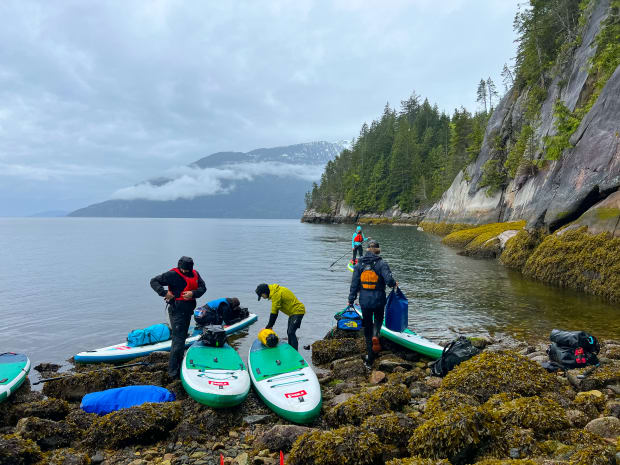
Jordan Cuvet
1. Choose the Right SUP
The ideal paddleboard will offer ample stability that lets you haul heavy loads long distances—including gathered foods on the water and land. Touring stand-up paddleboards are perfect for camping and foraging. Solid boards offer a sturdier platform but are heavier, harder to transport, and tougher to store. The newest inflatable boards are strong, lightweight, and a cinch to toss in a spare closet and your trunk. They’re the perfect compromise when factoring convenience, transporting, and storage.
Related: Paddling Safety 101: Always Check the Forecast
Red Paddle Co. has an array of touring options ranging from 11 to 15 feet that can work. The 15-foot tandem is ideal for partners and gear. Other brands offering an equally wide range of suitable models include Isle, Bote, Decathlon, and Hala. For an ultralight inflatable model, check out Kokopelli’s Chasm-Lite.
2. Meal Plan Ahead of Time
If you’re just traveling for the day, having a meal contingency plan isn’t essential. But for multi-day camping trips, it’s best to have a backup plan in regards to food. You’ll be thankful for having freeze-dried meals and other lightweight prepared foods on those less successful days of foraging and fishing from your SUP.
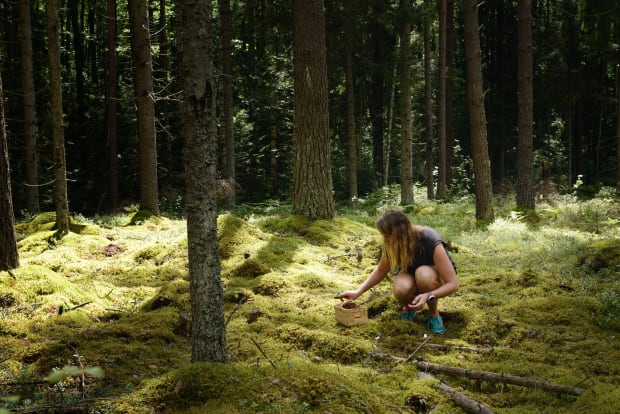
Getty
3. Think Seasonally
Winter is the toughest foraging season for obvious reasons, while spring through fall offers a range of wild foods depending on your location. Wild berries, mushrooms, nuts, roots, and leaves can all be edible as long as you have requisite knowledge of the local flora.
The entire dandelion plant, for example, is edible. Yep, that same ubiquitous weed you’ve written off as a nuisance on your lawn—leaves, flower, root, and all—can be used to make a healthy tea. Cattail roots and their young shoots, sassafras trees, some pine needles, and other commonly found plants are all fair game as well.
Related: 5 Secrets for a Perfect Paddling Day Trip
Red, brown, and green seaweed and kelp are all safe to consume. When harvesting, make sure to cut near the base, leaving the attachment point so it can continue producing. Seeweed is high in protein, contains omega-3 fatty acids, iodine, and vitamin B-12. It can be eaten as a standalone dish or used to flavor others.
Consult field guides for edible wild foods in your area. If you’re new to foraging, start small and supplement your meals with portions of collected items.
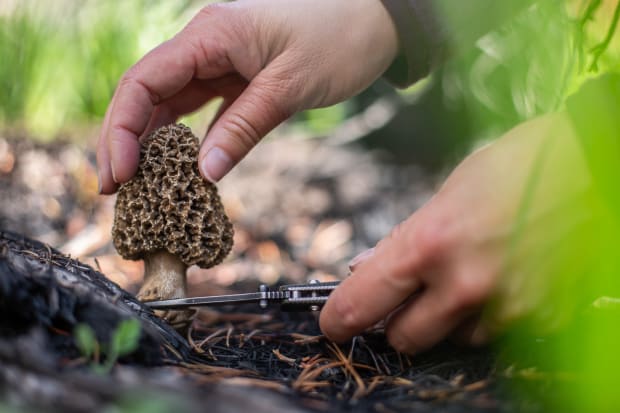
Getty
4. Be Wary of Fungus
It’s crucial when foraging for wild foods that you distinguish what’s safe and what isn’t. Mushrooms can be especially tricky—and toxic. When in doubt, simply avoid the risk altogether. Ominous mushroom names like “death cap” and “destroying angel” should deter one from venturing too far beyond their knowledge level in a quest for edible mushrooms.
If you want to try your hand at fungal collecting, two mushroom varieties—morels and chanterelles—are especially prized, delectable, and primarily found in the wild during short growing seasons.
Morels vary greatly in size, shape, color, and appearance—and have a more meaty texture and somewhat nutty flavor. Their outward appearance can vary from gray to a yellowish blonde color with a bulbous shape and distinctive honeycomb exterior. The interior of a morel is hollow and white. Use extreme caution, as there are also “false morels” out there, which are not hollow and exhibit varying color from yellow to a reddish-brown. Morels typically appear in the spring and are usually gone by early summer.
Related: The Year’s Best Inflatable Stand-up Paddleboards
Unlike morel, chanterelles grow from early summer until late fall, making it possible to have gourmet mushrooms across nearly three seasons. The most common variety to forage is the golden chanterelle. These can be easy to spot amidst the forest floor as their color ranges from deep orange to yellow, with asymmetrical, wavy-ish caps. One of their distinctive traits is a fruity aroma.
Both of these wild fungi would complement fresh fish or seafood beautifully on your journey. If you’re unsure how to identify them, don’t rely on guesswork. Leave it to a knowledgeable mushroom forager—hopefully accompanying you on your next paddling trip.
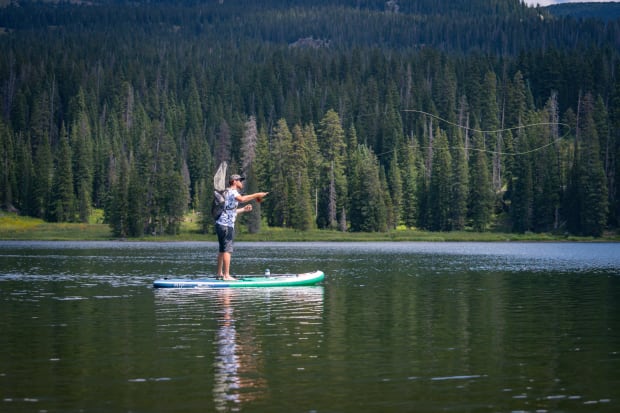
Jordan Cuvet
5. Cast a Line and a Net
Fish is the obvious protein-rich food source on a SUP trip. After all, you’re sitting or standing atop a mobile fishing platform. The type of fishing you attempt will depend on the chosen body of water—with lakes, rivers, tidal creeks, estuaries, and bays each having their own advantages. Freshwater usually offers easier-to-catch fish in calmer conditions, while saltwater allows for bigger, tougher fish and more unpredictable weather. Fly rods and standard spinning rods are both great choices for either type of water.
Cast nets are another lightweight option that can yield amazing results. Spotting a school of fish means that one well-timed throw may snag you a large dinner—or at least bait for your next fishing endeavor. In tidal creeks and back bays, one of the easiest catches with a cast net is the mullet—a great fish for grilling or pan-frying.
It’s also possible to passively troll for fish while paddling a SUP. Just drop one or more attached and baited lines into the water behind your board, and you’re “fishing” while paddling to your next site.
Related: The Best Saltwater Fly-Fishing Gear to Reel in the Toughest Fish
In the right saltwater locations, crab traps can provide a bountiful harvest. In fact, crabbing is one of the easiest ways to ensure a gourmet spread. If you carry along a trap, bait it with leftover fish caught earlier in the day or on the previous one. Even the bony pieces will work to reliably draw scavenging crabs.
If you don’t have a trap, try using a small piece of nylon rope, a small dip net, and some form of bait (like an old chicken or pork bone) tied tightly to the rope. Lower the bait into the water and have the dip net ready, as crabs may drop off before the bait breaks the surface.
Once any crabs are collected, make sure the size meets your state requirements and also return any female crabs of any size with visible eggs. Place in a bucket or small cooler (a key piece of gear when going for aquatic food) until you’re ready to cook.
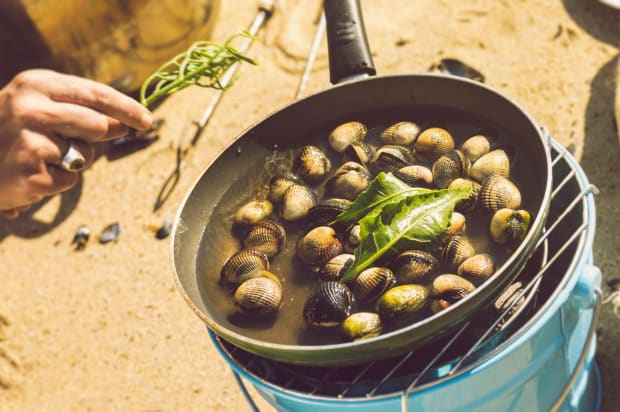
Getty
Clamming or collecting oysters is often the easiest aquatic harvesting of all. All you really need for clamming is a small, hand-held garden rake and something to put your caught clams in. Check the sand flats after the tide goes out for tiny telltale holes that occasionally bubble—and swiftly dig where you see those.
Related: America’s Backyard: Deep Sea Fishing North Carolina-Style
For oysters, search on the bottom of shallow water in the sand flats—then scoop them up with the rake or your hands. Be sure to check the shells, and toss back any that have cracks or are loose. Cook them in a pot of boiling seawater or by simply roasting them on a fire—providing a foraging feast either way.
Some areas are closed for collecting shellfish, so be sure to check with local regulations first. This applies to any other rules regarding fishing licenses, daily limits, and size restrictions.
6. Find a local guide
If new to the foraging game, look for a local expert. Experienced guides familiar with the area will likely know what foods are readily available at any given time of the year. Additionally, they’ll also be aware of any regulations and restrictions in the area. This database can help you locate an expert forager in your state or region.
Source link

